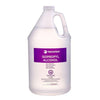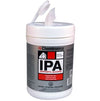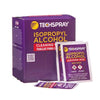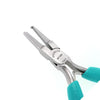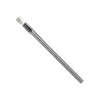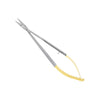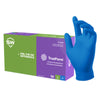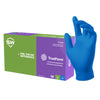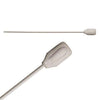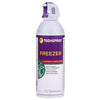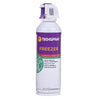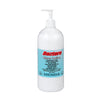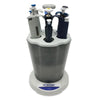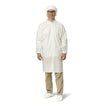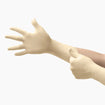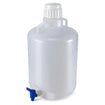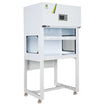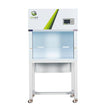- No products in the cart.
Beakers vs. Graduated Cylinders: The Pros and Cons of Common Lab Glassware
Jun
13
2020
From fleakers to viscosity tubes and everything in between, there are many options when it comes to purchasing glassware for your lab. You should always choose your laboratory tools carefully. The right tools will make your lab more organized, your results more reproducible, and your job easier. Conversely, trying to "make ends meet "with inappropriate tools can make things more difficult and messy than they need to be. A core need common to almost every lab is the need for high quality glassware. Glassware can be used to measure, mix, boil, crystalize, evaporate, dissolve, store, and much more. It’s also easy to clean and autoclave, and can be reused continually with the right care.
Since there are so many potential uses of glass in a laboratory, there are equally many types of glassware made to serve each purpose – so much so that it can be overwhelming when you need to choose what will best suit your needs. Today we’ll go back to the basics: beakers vs. graduated cylinders. We’ll explore the details of when, how, and why to use each of these laboratory staples, and the pros and cons for different circumstances
Beakers.
These containers, practically synonymous with ‘science’ itself, are used to contain and measure liquids. They are cylindrical with a flat bottom and can range to contain from 10mL to over 1L of liquid. Beakers are commonly used as a vessel to dilute concentrated chemicals, make buffers, or catch products during an experiment. They have graduations, but they are approximate measurements. The error of beaker graduations is usually approximated at 5% or greater, but can vary. Therefore, glass beakers can be heated and cooled as needed without much concern for distortion of calibration. All in all, beakers are a versatile container that is a laboratory staple for good reason.
Error:
-
5% or greater
Uses:
-
Rough estimates of liquid volumes
-
Containing buffers and solutions
-
Catching products/byproducts of an experiment
Pros:
-
Incredibly versatile – has a purpose in almost every lab type
-
Wide range of sizes and shapes
-
Available in glass or plastic
-
Can approximate liquid volume when strict accuracy is not necessary
-
Wide, flat glass bottom allows for stirring or heating on a hot/stir plate
-
Usually has a spout to aid pouring
Cons:
-
Not suitable for precise measurements
-
Wide mouth can lead to faster evaporation/vaporization
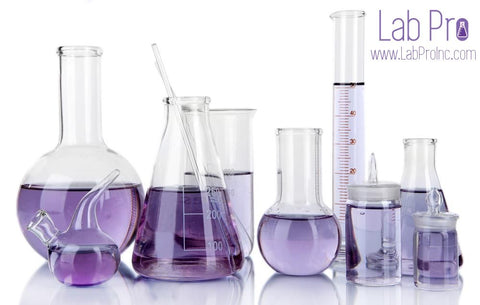
Graduated cylinders.
By description – a cylinder with a flat bottom that contains liquid and has graduations – a graduated cylinder might sound quite similar to a beaker. However, it’s more of a distantly related cousin than an immediate family member. The differences come down to the usage and accuracy. Graduated cylinders are designed for accurate measurements of liquids with a much smaller error than beakers. They are thinner than a beaker, have many more graduation marks, and are designed to be within 0.5-1% error. Graduated cylinders can be used for all sorts of applications from wastewater analysis to medical research. Therefore, this more precise relative of the beaker is just as critical to almost every laboratory.
Error:
-
Designed for 0.5% - 1%
Uses:
-
Precisely measuring liquid volumes, commonly ranging from 1mL to 1L
-
Providing analytical measurement of phase separation of liquids within the container (i.e. X% oil and Y% water)
Pros:
-
Also very versatile – has a purpose in almost every lab type
-
Wide range of volumes
-
Many graduations allow for accurate measurement of small volumes
-
Error can be minimized by choosing the appropriate size
-
Available in glass or plastic
-
‘To deliver’ volumetric container
-
Spout to aid pouring
Cons:
-
Error is still too high for some analytical applications
-
Requires some training to use (how to read a meniscus)
-
Tall, thin shape is not amenable to solution storage
Results of the Beaker vs. Graduated Cylinder Showdown
Both of these basic glassware items have a place in almost every laboratory. The trick is deciding which one is appropriate for your specific application. Are you measuring 7mL of ethanol for a 70% solution for an experiment? Use a 10mL graduated cylinder for accuracy. Need to buffer an already-made solution to pH 7.4? Pour it in a beaker and buffer away! Each piece of glassware is designed with a unique purpose in mind, and they each have their own (appropriate) place in a lab. Your experiments will become simpler and more reproducible by understanding what your lab equipment is for and how/when to use it.
For over 40 years, Lab Pro has been committed to delivering a complete laboratory solution by offering the highest quality glassware for our customers worldwide. Come visit the biggest Lab Supply showroom in California, or contact us online or at 888-452-2776.







